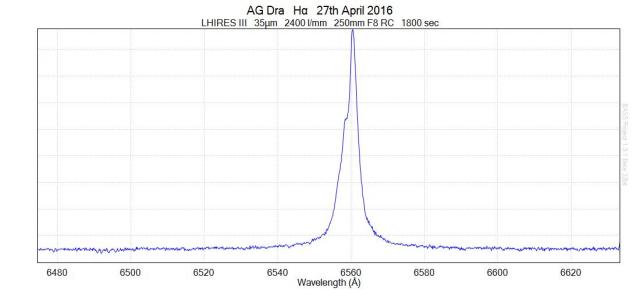› Forums › Spectroscopy › Outburst of the symbiotic star AG Draconis
- This topic has 1 reply, 2 voices, and was last updated 7 years, 11 months ago by
 Andy Wilson.
Andy Wilson.
-
AuthorPosts
-
5 May 2016 at 2:16 pm #573563
 David BoydParticipant
David BoydParticipantAn example of the useful work amateur spectroscopists can do is shown by observations of the current outburst of the symbiotic variable AG Draconis. This is a binary with orbital period 550 days consisting of a hot white dwarf and a cool K-type red giant star. The pair of stars is surrounded by a circumbinary nebula generated by a wind from the giant star. This wind is partially ionised by radiation from the hot white dwarf creating strong emission lines in the optical spectrum. During quiescence the white dwarf sustains a high surface temperature of ~100,000K by nuclear burning hydrogen-rich material accreted from the stellar wind onto its surface.
Since the beginning of March this year, the star has brightened from V mag 9.7 to currently 9.2. In doing so its colour has changed from B-V = 1.4 to 0.8. While photometry shows the star is brightening and becoming bluer, it is spectroscopy which tells us much more about the reason for this change.

These spectra show that the continuum level has risen causing the general increase in brightness, but also that there has been a more dramatic change in the relative strengths of the Hα, Hβ and He II emission lines. According to the professional literature, the changing ratio between the fluxes of the He II (4686) and Hβ emission lines from 1.0 on March 17th to 1.5 on April 29th is caused by an increase in the temperature of the ionising source, the white dwarf, from ~190,000K to more than 220,000K. These spectra were taken with a LISA spectrograph on a C-11 scope.
This is known as a “hot” outburst. The nature and mechanism of these outbursts is still unclear. The most promising current explanation is increased accretion onto the white dwarf and possibly also an increase in nuclear shell burning on the surface of the white dwarf. And it is still unclear whether AG Dra has an accretion disk. Amateurs who are following this outburst are gathering valuable data which will help professional astronomers develop better models to explain this behaviour.
Attachments:
8 May 2016 at 1:17 pm #577345 Andy WilsonKeymaster
Andy WilsonKeymasterA fascinating post David. It encourages me to take the next step and learn flux calibration.
Below is an H-alpha spectrum I obtained on 27th April. It is interesting to contrast that though I see detail in the profile, I miss even the nearby little blueward absorption line and redward emission line that you pick up. A good example of how low resolution and high resolution spectroscopy can complement each other.

Best wishes,
Andy
-
AuthorPosts
- You must be logged in to reply to this topic.
